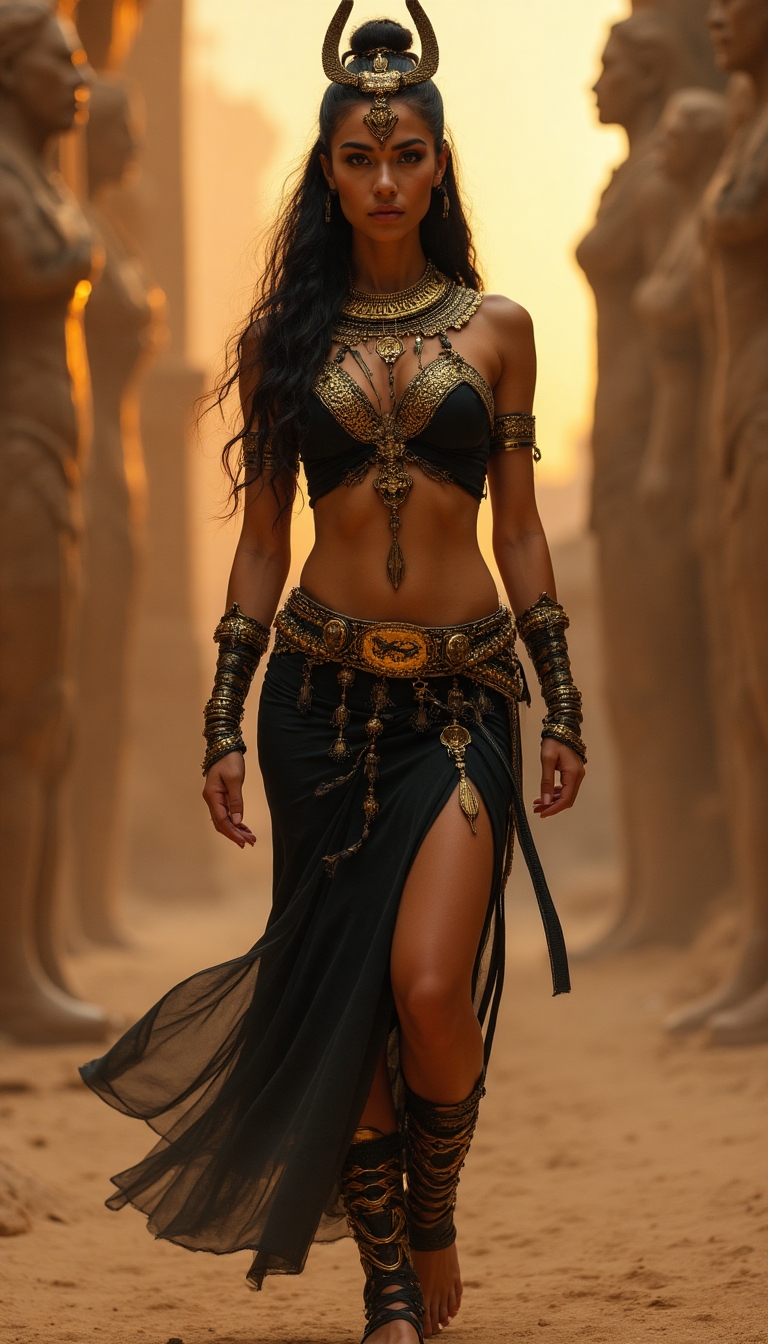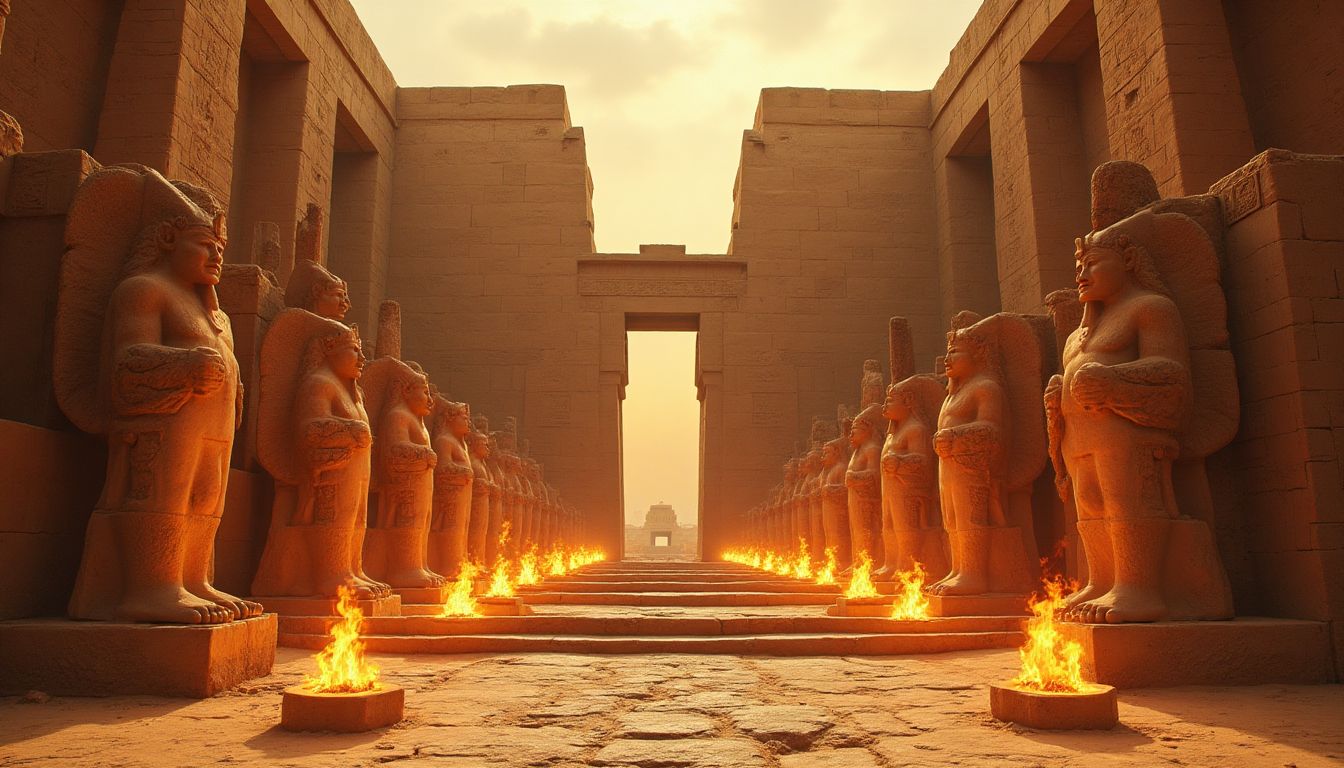For centuries, Egypt’s desert sands have concealed the echoes of powerful queens, builders, and scribes—but one recent archaeological discovery is shifting our understanding of female power in ancient Egypt. In the ruins of a remote temple complex near Upper Egypt, archaeologists have unearthed what appears to be the final resting place of a previously unknown warrior princess—a figure who challenges long-held assumptions about gender, authority, and warfare in the ancient world.
The Temple Discovery
Nestled beneath layers of collapsed sandstone and windblown sediment, the site was initially believed to be a minor religious outpost from the 19th Dynasty (circa 1290–1180 BCE). But what began as a standard excavation quickly transformed into a landmark find when a team uncovered a sealed chamber beneath the temple floor.
Inside: grave goods typically reserved for royalty—beaded linen, ceremonial daggers, painted ceramics, and most tellingly, a bronze-studded leather cuirass bearing a royal insignia flanked by lotus blossoms and falcons.
A single cartouche on a limestone stela referred to the buried figure as "Setepenmut, Daughter of the Lioness, Commander of the Horizon."
A Warrior, A Royal, A Woman
While women in ancient Egypt enjoyed more rights and freedoms than their counterparts in many other ancient societies, their roles in military and administrative command were still rarely commemorated in funerary records. That’s why this discovery is so significant.
Setepenmut—if that was indeed her name—was more than a princess consigned to ceremonial duties. Murals along the temple walls depict her in active battle: riding a chariot, drawing a bow, and leading foot soldiers. Nearby inscriptions speak of "defending the sacred boundaries of Kemet" and being "beloved of Sekhmet," the lion-headed goddess of war and healing.
This was not symbolic. This was state-sanctioned leadership.
And it was female.
Breaking Traditional Narratives
Mainstream Egyptology has long focused on male figures—pharaohs, priests, generals—often casting female power in religious or dynastic terms alone. But findings like the warrior princess’s tomb demand a broader perspective.
This woman held authority not simply as the daughter of royalty but as a tactician, a combatant, and a protector of state borders. Her regalia was not ornamental; her weaponry was functional. Even her burial position—shield resting across the torso, blade placed to her right—mirrors that of high-ranking military officials, not priestesses.
Such a depiction questions the assumption that Egyptian women in power expressed influence solely through soft diplomacy, spiritual mediation, or regency. Here was a woman who led with strength, not only in lineage but in warfare.
Art, Architecture, and Status
The design of the burial chamber further supports the theory of Setepenmut’s elevated rank. The temple structure deviates from typical funerary design. While much of the inner chamber features floral and solar motifs—hallmarks of dynastic art—it also contains military iconography: rows of bound captives, weapon stockpiles, and procession scenes of armed retainers.
Artifacts recovered include:
-
A curved khopesh blade inscribed with royal dedications
-
Beaded armor dyed in indigo and saffron hues
-
A lapis-lazuli inlaid seal bearing the title “Shield of the South”
-
Burnished pottery engraved with both protective spells and campaign records
Analysis of the pigments and carving styles has dated the site to the later reign of Ramesses II, a time known for expanding military campaigns into the Levant. Could Setepenmut have commanded forces during one of these expeditions?
Some scholars think so.
Why This Matters Today
The discovery of the warrior princess's tomb represents more than another exciting chapter in Egyptology—it is a reminder that history is not static. New finds continue to disrupt established narratives, offering space for stories long buried by time and assumption.
Setepenmut’s legacy—emerging from a forgotten crypt—is now part of a growing body of evidence that ancient Egyptian society, while hierarchical, could also be remarkably fluid when it came to gender roles in leadership and military affairs.
In a time when women around the world continue to fight for equal representation in politics, leadership, and defense, this ancient figure sends a timeless message: we have always been here.
Unanswered Questions
Despite the breakthroughs, much about the warrior princess remains unknown. No records of her exist in official dynastic lists. Was she erased? A daughter of a secondary queen? A provincial leader elevated by merit? Or a symbol of a brief but significant shift in gender dynamics during a time of military unrest?
Scholars continue to examine:
-
DNA samples from the burial site
-
The linguistic quirks of the inscriptions
-
Traces of contact between Nubian, Levantine, and Egyptian cultures in the temple murals
As more details surface, the image of Setepenmut may sharpen—or splinter into something even more unexpected.
Conclusion: Rewriting the Legacy of Power
The sands of Egypt continue to whisper. With each excavation, we draw closer to voices once thought silenced. The discovery of a warrior princess buried in an ancient temple reminds us that strength and sovereignty have never worn just one face.
As Egyptologists continue to decode her story, we are all invited to reconsider our assumptions—about gender, about power, and about the hidden chapters of history that still wait, just beneath the surface.
To stay updated and officially join the dynamic conversations happening in the city, consider subscribing to the "Shining City on the Web." Like, share, and challenge the ideas explored here; let's continue unraveling the tapestry of existence together!
The Secrets Beneath the Sands
Prologue
Dust danced in the beams of the setting sun as Dr. Anya Khem knelt before the half-buried entrance of an ancient temple on the desolate planet Tethys IV. Clad in utilitarian gear accentuated with intricate gold embroidery reminiscent of ancient Egyptian adornments, she was a vision of worlds colliding—modern technology intertwined with timeless elegance.
The Discovery
Every breath she took filled her lungs with the scent of antiquity. The air whispered secrets of the past, tales long locked away beneath the unyielding sands. The time crystals embedded in the walls pulsed with a soft, ethereal glow, casting a halo around her determined features. With her raven-black hair pulled into a practical braid, and her deep violet eyes reflecting both curiosity and a hint of foreboding, Anya activated her tricorder, scanning the surroundings.
As the readings streamed onto her screen, a frantic beeping broke the stillness. "This can't be right," she murmured, unable to contain her excitement. The figures on the display hinted at an unprecedented find—something buried deeper than mere stone and sand. A series of glyphs formed a pattern, leading away from the entrance. Each symbol promised to tie her to a civilization of unimaginable depth.
A Fateful Collision
“Dr. Khem! We have a situation!” her colleague's voice, break-tensed with urgency, echoed behind her. Tarek, a wiry man with tousled auburn hair, hurried towards her, eyes wide with a mix of awe and panic. He wore a similar outfit, functional yet adorned with tribal markings borrowed from distant cultures—but he mirrored Anya's turmoil too narrowly for her liking.
“What is it, Tarek?” she asked, her brow furrowed.
A flurry of heat surrounded them as a series of explosions echoed in the distance, shaking the very ground beneath their feet. Anya's heart raced. "Tell me you brought the field gear!" She could already feel the tension morphing into something darker—a familiar presence pinning them down to the layers of the past.
The Awakening
The pair dashed toward the temple, the ancient structure standing sentinel against the chaos. Just as they crossed the threshold, light poured into the chamber, illuminating a room adorned with mesmerizing murals depicting cosmic deities intertwined with grand tales of humans. Anya gasped, finally grasping the import of her discovery; this was no ordinary archaeological site. The flickering lights pulsated in their own rhythm, resonating with an unseen energy.
“We need to make a record of this,” Anya asserted, her instinct for exploration pushing her forward. But Tarek held her back, his face slick with worry.
“The disruptions—there are consequences. We cannot unleash what lies in these halls!” His voice cracked with desperation.
“Knowledge is worth any risk!” Anya retorted, a fire igniting in her chest, the stakes higher than she’d ever faced before.
A Fractured Choice
But Anya’s conviction was met with an echo of disapproval, reverberating through her mind. The choice to reveal these secrets thrust her deeper into a web woven from ancient threads—a tapestry that linked their fates to those long past. As she advanced, she could almost hear the whispers of the dead warning her, their spectral breaths warning against the foolish erasure of boundaries.
“We can’t disturb them! It might trigger something beyond our control!” Tarek insisted, a mix of dread and admiration swirling in his expression.
For a moment, the weight of one decision bore heavily on her. Should she turn back, saving their lives but potentially losing eons of knowledge, or forge ahead into darkness? The cosmic patrons whose legacies filled the room were calling her, begging for a voice.
The Revelation
With a deep breath, Anya reached for the crystal embedded in the foundation. Its warmth pulsed against her palm, flooding her with visions of generations establishing cultures, treasuring stories nestled within these walls. A sudden shockwave erupted, throwing both archaeologists to the floor. Shadows spiraled above them, forming figures in the air—mythical beings wrapped in golden threads of time. Anya’s heart raced as she realized that they had awakened guardians.
To their horror, the temple began to shift, walls vibrating in tandem with the cries of long-silenced spirits. “Anya!” Tarek shouted, scrambling for a grip as tremors intensified.
'The temple—' she thought. 'It’s alive.' The true mystery lay not in merely uncovering it, but understanding the web woven between them and the very fabric of existence itself.
Conclusion: The Path Forward
As the temple’s protective barriers flickered to life, Anya and Tarek were enveloped in shades of light. Emblems encompassed them, knitting together centuries of history with threads of discovery and narrative, a blessing from those who once roamed this space. Fighting against reverberating shadows, they knew their expedition was just the beginning, the first step into a time long forgotten.
“We leave, or we embrace this,” Anya whispered, reverberating the choice that lay before them. Tarek nodded solemnly. They were the voices of these ancient souls now, navigating the treasures of darkness, ready to delve into interstellar mysteries anew.
And with that, they chose to step further into the light.
Disclaimer: This article may contain affiliate links. If you click on these links and make a purchase, we may receive a commission at no additional cost to you. Our recommendations and reviews are always independent and objective, aiming to provide you with the best information and resources.
Get Exclusive Stories, Photos, Art & Offers - Subscribe Today!

























Post Comment
You must be logged in to post a comment.